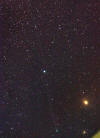C/2007 F1 LONEOS
Closest to Earth on 28 Oct 2007 at 0.71AU
Closest to Sun on 28 Oct 2007 at 0.40AU
Maximum magnitude 5 in Oct 2007
Comet C/2007 F1 LONEOS was closest to the Sun on October 28, 2007 at a
distance of 0.40AU. Initially the comet was only visible from northern
hemisphere latitudes and reports in September suggested a rapid rate of
brightening as it approached perihelion, possibly achieving a maximum
brightness of magnitude 4 in late October. However the brightening rate stalled
during October and comet LONEOS only reached 5th magnitude during perihelion.
The first southern hemisphere observations occurred in early
November when the
comet was situated very low in the south-western sky in the
constellation of Scorpius.
On the evening of November 3,
comet C/2007 F1 was a degree west of magnitude
7.3 globular cluster M80. On
the following 2 nights the comet was within 2 degrees
of magnitude 5.6
globular cluster M4 near Antares.
My observations indicated rapid fading of this comet during November.
2007 Nov 5.42 UT: m1=6.0, Dia.=3', DC=7...25x100mm Binoculars
2007 Nov 6.42 UT: m1=6.7, Dia.=3', DC=6...25x100mm Binoculars
2007 Nov 7.42 UT: m1=7.4, Dia.=3', DC=6...25x100mm Binoculars
2007 Nov 8.42 UT: m1=7.4, Dia.=3', DC=6...25x100mm Binoculars
2007 Nov 10.43 UT: m1=7.6, Dia.=3', DC=6...25x100mm Binoculars
2007 Nov 11.43 UT: m1=7.8, Dia.=3', DC=6...25x100mm Binoculars
2007 Nov 13.43 UT: m1=8.3, Dia.=2', DC=5...25x100mm Binoculars


C/2007 F1 LONEOS November 10.43 UT
3x2 minute exposure ISO 800 with a Canon 300D digital camera + 100mm zoom lens,
cropped. Right: negative image
Comet is at bottom left. Note a 6 degree long but very faint tail extending
towards the lower centre of the image. The star cluster at top left is NGC 6231.
Field of view 10 degrees wide.

C/2007 F1 LONEOS November 5.42 UT.
3 minute exposure ISO 800 with a Canon 300D digital camera + 300mm zoom lens,
cropped.
The ion (gas) tail of the comet is 5 degrees long in this image and passes
through Tau Scorpii. Note the bright star Antares and globular star cluster M4
to the lower right. A satellite track is also visible crossing the image.


